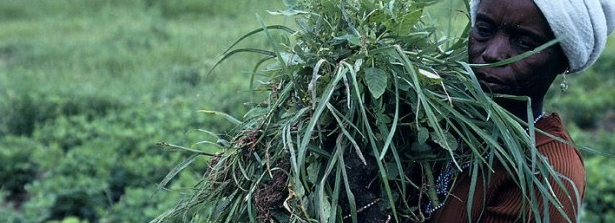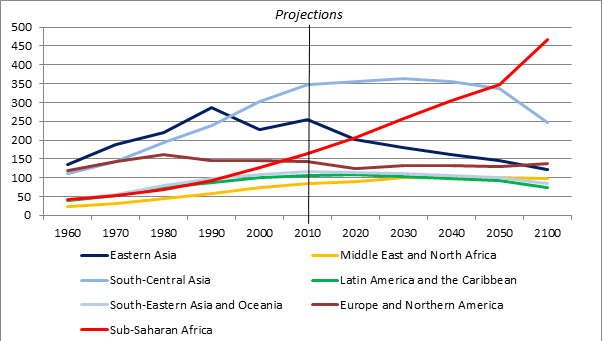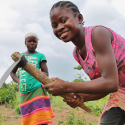Youth employment and agriculture in Sub-Saharan Africa

Agriculture has an important role to play in tackling the youth unemployment challenge in Sub-Saharan Africa. Moreover, integrating the dynamism, energy and innovative potential of youth in agriculture is crucial to increase agricultural productivity in Sub-Saharan Africa, to meet the food and nutrition needs of its population, and to increase the competitiveness of African food markets. Yet, young people, especially women, face significant constraints related to access to land, financial services and training. Investment in smallholder farming is crucial to tackle such constraints and to increase the attractiveness of agriculture to young people.
In Africa today, over 60% of the population are below the age of 25.1 Figure 1 shows that the youth population will continue to rise in Sub-Saharan Africa throughout the 21st century, even though it is projected to decline in other regions.2 In rural areas, the number of young people will continue to expand into the 2030s.3 But what does this mean for development, food security and employment in Africa in the decades ahead?
These numbers of young people represent a potential demographic dividend – but only if enabling policies drive the generation of sufficient numbers of decent jobs for them. Considering the concurrent need to transform agriculture and food systems to feed the continent’s 220 million undernourished people,4 there is significant potential in adopting an integrated view of the twin challenges of generating employment for Africa’s youth on the one hand, and transforming the continent’s agriculture on the other.
Figure: Projected youth population by region*
*Based on data from United Nations (2011), cited in: Proctor and Lucchesi (2012), op cit.
Youth will be key to the future of African agriculture
The role that agriculture must play in meeting the youth employment challenge facing Africa is substantial. Even under the most optimistic scenarios, non-farm and urban sectors are not expected to be able to absorb more than two-thirds of youth labour market entrants over the next decade.5 At the same time, the dynamism, energy and innovative potential of young people will be an important resource as agricultural systems adapt to a range of challenges in the decades ahead, including:
- Raising agricultural production by 60% to feed a population in excess of 9 billion by 2050
- Adapting to and mitigating the effects of climate change
- Redressing biodiversity loss and preserving ecosystems
- Competing in more interconnected and demanding national and global food markets
The challenges are significant, but the potential is enormous
The scope of the challenges should not be underestimated. Key natural resources, biodiversity and ecosystems upon which agriculture is reliant have been degraded or lost – in some cases irreversibly. Meanwhile, climate change is already leaving its mark on rural landscapes, and will do so on a much greater scale in years to come. At the same time, in some regions, rural-urban connectivity remains poor, particularly in terms of infrastructure, as do the services and institutions required to facilitate flows of goods, information, money and people.
While the challenges may be significant, the potential benefits of addressing them are enormous. Higher prices, more integrated value chains, widening connectivity to markets in some areas, and greater private and public engagement in the sector are creating new opportunities.
This has been demonstrated by initiatives targeted at young people by organizations such as the International Fund for Agricultural Development (IFAD). In the Niger Delta, for instance, the IFAD-supported Community Based Natural Resource Management Programme is fostering of a new category of entrepreneur-cum-mentor called the ‘N-Agripreneur’. These N-Agripreneurs are dynamic university graduates who own and run medium-scale enterprises at different stages of food value chains. Their role is to promote rural-urban linkages by acting as intermediaries between small-scale market-oriented farmers, and large-scale agro-industries and wholesalers. The N-Agripreneurs deliver business development services to producers, especially young people, who are interested in agro-based activities, such as farming as a business, small-scale processing, input supply and marketing. The result has been more interconnected, stable and prosperous communities and local food systems, as well as jobs for the (mostly young) entrepreneurs.6
Fulfilling the potential of youth in agriculture: policies and practice
So it is clear that young people must play a key role in enabling Africa to meet the food and nutrition needs of its population in the decades ahead. But what must happen to enable them to fulfil this role? And how can policy-makers make agriculture attractive to the youth of today and tomorrow at a time when there is a perception of young people abandoning rural areas to search for opportunities in the cities?
First, we must shake-up the image of agriculture to make it appealing to young Africans. This means investing in smallholder farming – the dominant modality of agriculture across Africa – providing smallholders with access to modern technologies, training, and markets and extending and adapting financial services to suit the needs of young farmers. Responsible investments, innovative partnerships between public and private actors, which include smallholders and their organizations, linking rural and urban areas through integrated planning using intermediate towns to connect rural people to markets and providing smallholders with tools (including financial products and services) to adapt to, and mitigate the effects of, climate change can all play a role in this respect. In addition, specific, targeted measures are needed to expand the access of and rights to land of young people, with a particular focus on the needs of young women.
Second, if young people are to engage in productive, profitable agriculture responding to the environmental, economic and nutrition challenges of the future, they will need opportunities to develop suitable capacities. Education policies and investments are urgently needed to upgrade formal schooling in rural areas, including by adapting curricula to address key agricultural issues and competencies, and taking concrete steps to widen access (for instance, through conditional social transfers), especially among girls, who are particularly likely to drop out.7
Third, ICTs can also play a major role in developing young people’s capacities, while improving communication and easing access to information and decision-making processes. Investing in extending these technologies to rural areas, in particular targeting young people – who are generally more adaptable to their use – has allowed especially young farmers to keep themselves up-to-date with market information and new opportunities, and has provided an important avenue for upgrading and extending the outreach of existing training programmes.
Fourth, specific efforts are needed to include the voices of young rural people in policy and planning processes surrounding food and agriculture. While youth issues are receiving greater attention across Africa, young people living in rural areas are all too often absent from relevant debates and their specific needs and aspirations are unknown or not taken into account.8 Supporting and engaging with youth organizations – particularly in rural areas – as well as facilitating youth engagement in farmers’, rural workers’ and women’s organizations will be key to building a policy and institutional environment capable of developing an agriculture sector that is attractive to young people.
Much good practice and knowledge in these areas already exists and documenting, scaling-up and adapting these holds much promise. But a more inclusive and youth-sensitive institutional and policy environment is needed, where growth is broad-based and job rich, inequality reduced and the young people of today are presented with viable opportunities to drive a modern agriculture capable of feeding Africa.
Thanks to Bettina Prato, Anja Lund and Elena Pietschmann from IFAD’s Global Engagement and Research Division, who contributed comments and suggestions on a draft version of this blog.
This article was published on the website of the Knowledge Platform on Inclusive Development Policies on November 18, 2015.
Footnotes
- 1. UNDESA (2013) Cross-national comparisons of internal migration: An update on global patterns and trends. Population Division Technical Paper No. 2013/1. New York: United Nations Department of Economic and Social Affairs.
- 2. United Nations (2011) World Population prospects. The 2010 Revision. New York: United Nations, Department of Economic and Social Affairs, Population Division, cited in: Proctor, F. and Lucchesi, V. (2012) Small-scale farming and youth in an era of rapid rural change. London and The Hague: International Institute for Environment and Development & Hivos.
- 3. Van der Geest, K. (2010) Rural youth employment in developing countries: A global view. Overview synthesis No. 1. Rome: FAO, Gender, Equity and Rural Employment Division.
- 4. FAO, IFAD and WFP (2015) The state of food insecurity in the world 2015. Meeting the 2015 international hunger targets: taking stock of uneven progress. Rome: FAO.
- 5. Jayne, T.S., Ferdinand, M., and Traub, LN. (2014) Africa’s evolving food systems: drivers of change and the scope for influencing them. IIED Working Paper. London: IIED.
- 6. IFAD (2015) Entrepreneurship and micro-enterprises for rural youth in West and Central Africa, [online]. Available at: <http://www.ifad.org/english/youth/regional/wca/bests/enterprises.htm>, [accessed 16 October 2015].
- 7. UNESCO (2012) Youth and skills: putting education to work. EFA Global Monitoring Report 2012, Chapter 7: Skills for rural youth – an escape route from poverty. Paris: UNESCO.
- 8. Vargas-Lundius, R. and Suttie, D. (2014) Investing in young rural people for sustainable and equitable development. Rome: IFAD.






